Building power is about what your legs can push round, and how your upper body can move the bike around underneath you. To work on both, you need to do some off-the-bike exercise. This can be done fairly easily two or three times a week before or after work – or even in your lunch break if you have access to a gym.
Workout session plan
1. Dumbbell squats
Sprinting uses your quads and glutes and dumbbell squats are a great way of reinforcing what you do on your bike. They can be done easily at home, or anywhere really. Using weights will achieve a higher resistance through fewer reps.
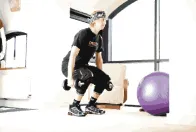
- Keep your knees shoulder-width apart and hold the weights by your side
- Slowly lower yourself at the knee until your thigh is horizontal, and return
- Work on low reps with high weight dumbbells and then higher reps with lower weight dumbbells to get a good mix of power and leg speed
2. Upright dumbbell rows
Sprinting and jumping on a bike uses elements of both pulling and pushing with your arms. Upright dumbbell rows mimic this movement.
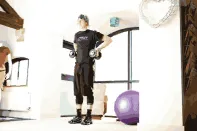
- Stand with the dumbbells at your side and your palms facing the front of your thighs
- Pull the dumbbells up to your shoulders, leading through your elbows and allow your wrists to flex, working the forearm
3. Dumbbell hammer curls
The motion of a hammer curl is similar to that of a bicep curl, and really works your forearms, biceps and triceps, which gives you the strength you need to push the bike into the ground for pumping.
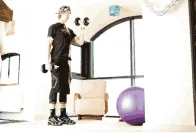
- Holding the dumbbells by your side, raise one dumbbell until your forearm is vertical and your thumb is facing your shoulder
- Control the motion both up and down, rather than ‘bouncing’ the weights – this isn’t effective and can lead to injury
4. Press-ups
The good old fashioned press-up builds powerful shoulders, triceps and chest - all of which are useful for pumping, jumping and sprinting. There are two ways of performing press-ups – with a wide stance, and with a narrow stance.
Start with the wide stance:
- Put your palms flat on the floor and your arms a little over shoulder width apart.
- Lower yourself with control and return.
Narrow stance: To work your triceps more and your chest less
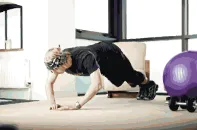
- Move your hands closer together so your thumbs and index fingers are touching
- You can also work your core muscles and arms independently by using a medicine ball or similar – have one hand on the ball and the other on the floor
- Carry out a set then swap hands
5. Core stability
This exercise requires a gym ball.

- Kneel on the ball
- Tighten your stomach muscles and use these to balance yourself
- The firmer your ball is, the harder it will be to balance, and therefore you’ll work your stomach muscles more
Post-session stretching
Stretching is really important both before and after riding. Combine these stretches with the ones demonstrated in part two of this Winter Warrior feature and you’re on your way to a good set of stretches for upper and lower body.
1. Hand down spine
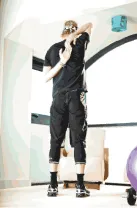
- Raise one arm over your head
- Extend your hand to the middle of your back, with your fingers pointing downwards
- Grab your fingers with your other hand
- Breath out slowly, and gently pull downwards until you feel the stretch
- Hold for 30 seconds
2. Lock hand over shoulders

- Interlock your fingers above your head, with your palms facing upwards
- Exhale and stretch your hands further above your head
- Feel the stretch in your shoulders
- Hold for 30 seconds
3. Look at the ceiling
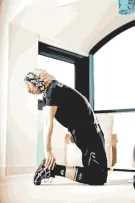
- Kneel on the floor and hold your ankles with both hands
- Slowly exhale and lift your buttocks up and forward
- Move your head back and look at the ceiling until you’ve arched your back
- Feel the stretch, again for 30 seconds
What to eat
Fuelling your body is essential for the muscles to grow and stay strong. A balanced diet is essential, the key elements of which are carbohydrates, proteins and fatty acids (Omega 3, found in fish).
Great foods to replenish stripped carbs and proteins include lean red meat, chicken, eggs, potatoes, fish (oily fish like mackerel), pasta and rice. A thick chowder packed with fish, potatoes and rice is ideal to warm you and feed your muscles. Try this recipe:
Fish Chowder Cooking time: 25mins
- 1 packet smoked mackerel
- Five new potatoes
- A leek
- A few sticks of celery
- A savoury rice pack
- Bay leaves
- Chilli powder
- Milk
- Cornflour
- Two stock cubes
- Lemon juice
- Crème fraîche
- Chop the leeks and celery and fry on a medium heat in a deep pan
- Dissolve two stock cubes into two pints of hot water and add half to the saucepan
- Cube the potatoes, and add to the saucepan along with the rice
- Top up the stock gradually until it’s all in the pan
- Thicken the mixture with 1tbsp cornflower mixed with 2tbsp milk
- When the potatoes and rice are cooked though, flake the mackerel and stir it into the pan
- Add chilli powder and lemon juice to taste
- Serve with big dollop of crème fraîche
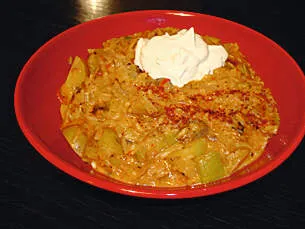
What to drink
As well as keeping yourself hydrated during exercise, it’s important to rehydrate properly afterwards. After a hard work-out, you need to replace your salts and sugars, but you should also feed your muscles with protein.
Try blending these ingredients together to make a great recovery milkshake:
- 8fl oz semi-skimmed or skimmed milk
- 1tbsp peanut butter
- 1 banana
- 2 scoops of whey protein powder
